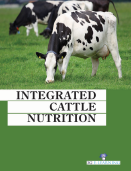Animal and Veterinary Science

The proper nutrition of cattle is a key component of a successful production system. Feed usually accounts for the single largest input cost associated with cattle. Feeding diets with lowered protein content reduces nitrogen input, improves nitrogen utilization e ciency, and reduces nitrogen losses from manure. Reducing dietary protein also bene ts the producer by reducing feed cost and improving overall farm pro tability. These interventions, however, have to be balanced with the risk of loss in milk production. If the true animal requirements for metabolizable protein are not met, long-term production cannot be sustained. Certain nutrients are required by beef cattle in the daily ration, whereas others can be stored in the body. When body stores of a nutrient are high, e.g., vitamin A, dietary supplementation is unnecessary until such stores are depleted. However, it may be di cult to determine when body stores have been depleted until advanced signs of de ciency start to appear. Hence, a knowledge of the basic digestive system of cattle and the role of various nutrients is important. Combined with accurate feed analysis, it allows the formulation of balanced rations which will meet production goals in an economic manner. It also enhances the management of the feeding program by providing the background information necessary to prevent or resolve problem situations.